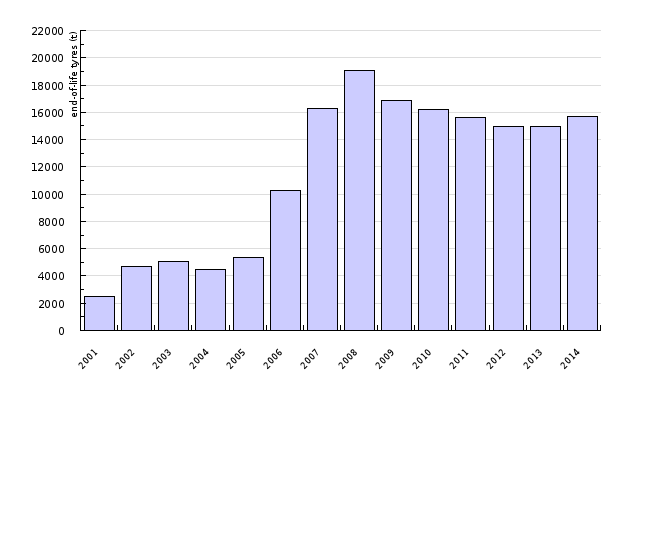[OD15] End-of-life tyres 

Key message

The quantity of end-of-life tyres collected for recovery increased dramatically when producer liability was introduced. The success of the system of management of end-of-life tyres is measured by the level of recovery. The average level of recovery in the EU-15 Member States in 2005 was 85%. In Slovenia, measures were taken to reach this percentage, which is also the target level of the EU.
Definition
The indicator shows the number of end-of-life tyres collected for recovery.
An end-of-life tyre is a car tyre that the owner cannot or will not use due to damage, wear, and other causes, and therefore discards it or plans to discard it. End-of-life tyres are waste tyres from personal vehicles, semi-trailers, lorries and mobile machinery from the group of waste with the classification number 16.01.03 in accordance with the regulation governing waste management, and other scrap tyres that are similar to car tyres in their composition. An end-of-life tyre is also a car tyre that is returned by the end user to the distributor based on a complaint concerning a defect of delivered goods (Decree on the manner, subject of and conditions for performing mandatory public utility service for the management of waste tyres, Official Gazette of the Republic of Slovenia No. 71/06).
Charts
Concessionaire Reports, Ministry of the Environment and Spatial Planning, 2009
| 2001 | 2002 | 2003 | 2004 | 2005 | 2006 | 2007 | 2008 | 2009 | 2010 | ||
|---|---|---|---|---|---|---|---|---|---|---|---|
| collected and delivered for recovery end-of-life tyres | t | 2485 | 4668 | 5067 | 4467 | 5327 | 10250 | 16300 | 19080 | 16862 | 16230 |
| 2011 | 2012 | 2013 | 2014 | ||||||||
| collected and delivered for recovery end-of-life tyres | t | 15606 | 14929 | 14969 | 15665 |
Goals
- To establish a unified system of collecting end-of-life tyres on the entire territory of the Republic of Slovenia,
- To prevent unauthorised disposals,
- To prevent unauthorised disposals.
Comment
The number of end-of-life tyres is growing proportionately with the increase in the number of registered motor vehicles. The management of end-of-life tyres is regulated by the Decree on the management of end-of-life tyres (Official Gazette of the Republic of Slovenia, No. 63/09), which became effective on 22 August 2009 and superseded the Decree on the manner, subject of and conditions for performing mandatory public utility service for the management of waste tyres (Official Gazette of the Republic of Slovenia, No. 71/06) which regulated the manner and subject of public service management of end-of-life tyres on the territory of the Republic of Slovenia. Regardless of this change, management of end-of-life tyres will be carried out as a confessional public service until the end of 2009, while in 2010 the extended producer's responsibility/liability for the management of end-of-life tyres will be implemented. The economic operators who first place the tyres on the market in the Republic of Slovenia will be obliged to organise and finance the management of end-of-life tyres in accordance with the requirements of the Decree. Since December 2002, the public service of end-of-life tyres management has been performed by three concessionaires. Up until august 2006, the public utility service was paid for by the users (the "generators" of end-of-life tyres), and the concessionaires annually collected around 2.5 kg of end-of-life car tyres per capita per year, while the average annual quantity of collected end-of-life tyres in EU is around 7 kg per capita. To make the system of end-of-life tyres management more efficient, environmental tax in the form of producer liability was introduced in the second half of 2006. From the viewpoint of collected quantities, the measure proved successful; the quantity of end-of-life tyres collected for recovery has increased significantly. The quantities of collected end-of-life tyres increased from 5,300 tonnes in 2005 and 2,000 tonnes in the period from January to July 2006, to 8,250 tonnes in four months to the end of 2006; in 2007, the collected amount was above 16,000 tonnes, and in 2008, nearly reached 17,000 tonnes (8.4 kg per capita). In addition, 2,300 tonnes of stored end-of-life tyres were delivered for recovery in 2008. End-of-life tyres are either recycled or incinerated with energy recovery, while a rather small quantity is returned for reuse or regeneration. Proportionately with greater collection of end-of-life tyres from 2006 onwards, increased the quantities of end-of-life tyres delivered for recovery (Table X). In 2007, 55% of end-of-life tyres were recycled, and 43% incinerated, while in 2008, 47% of end-of-life tyres were recycled and 50% incinerated. In addition to recovery in Slovenia, end-of-life tyres were also sent to recovery in Austria, Hungary and Croatia.
With regard to average monthly quantities of collected end-of-life tyres in the periods after the system was changed in 2006, annual quantities of end-of-life tyres generated can be estimated at between 16,000 and 18,000 tonnes which substantially differs from the estimates of 14,000 tonnes at the time when the system was first introduced. In terms of data collected through the levied environmental tax on end-of-life tyres, about 18.000 tonnes of tyres are placed on the market per year in the Republic of Slovenia.
Methodology
- Reports by concessionaires, 2007
- Ministry of the Environment and Spatial Planning
- Decree on the manner, subject of and conditions for performing mandatory public utility service for the management of waste tyres (Official Gazette of the Republic of Slovenia, No. 71/06).









